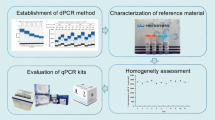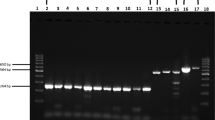Abstract
A specific multiplex PCR was developed for the rapid and highly sensitive quality control of the viral DNA during Epinotia aporema granulovirus (EpapGV) production. At the beginning of this work only 2.3% of the EpapGV genomic sequence was known. In order to increase the availability of specific information, the terminal sequences of the inserts of several selected clones of EpapGV genomic libraries were determined. These data comprised 8.4% of the total DNA sequence and corresponded to regions distributed throughout the genome. Based on the small fraction of known sequence available a set of 32 primers was designed, using information theory to set the basis for this study. Each pair of designed primers was initially tested in individual PCRs to assess the correct size of the expected product and the sensitivity of the amplification. The specificity was verified in multiplex PCRs, using alternatively 1–3 sets of selected 5–6 primer pairs and EpapGV DNA preparations from different sources and degrees of purity. The results indicate that the multiplex PCR could be used for quality control in the bioinsecticide production, as well as in other applications such as the detection of latent infections in E. aporema colonies, and studies related to virus distribution, vertical transmission, host range, or persistence in the field.




Similar content being viewed by others
References
A. Sciocco-Cap, A.D. Parola, A.V. Goldberg, P.D. Ghiringhelli, V. Romanowski, Characterization of a granulovirus isolated from Epinotia aporema Wals. lepidoptera: tortricidae larvae. Appl. Environ. Microbiol. 67, 3702–3706 (2001). doi:https://doi.org/10.1128/AEM.67.8.3702-3706.2001
P.F. Entwistle, A world survey of virus control of insect pests, in Insect Viruses and Pest Management, ed. by F.R. Hunter-Fujita, P.F. Entwistle, H.F. Evans, N.E. Crook (Wiley, Chichester, England, 1998), pp. 189–200
F. Moscardi, Assessment of the application of baculoviruses for control of Lepidoptera. Annu. Rev. Entomol. 44, 257–489 (1999). doi:https://doi.org/10.1146/annurev.ento.44.1.257
D.A. Theilmann, G.W. Blissard, B. Bonning, J. Jehle, D.R. O’Reilly, G.F. Rorhmann et al., Baculoviridae. in Virus Taxonomy, VIII Report of the International Committee on Virus Taxonomy, ed. by C.M. Fauquet, M.A. Mayo, J. Maniloff, U. Desselberger, L.A. Ball (Elsevier, London, 2005), pp. 177–185
J.P. Burand, H.M. Horton, S. Retnasami, J.S. Elkinton, The use of polymerase chain reaction and shortwave UV irradiation to detect baculovirus DNA on the surface of gypsy moth eggs. J. Virol. Methods 36, 141–149 (1992). doi:https://doi.org/10.1016/0166-0934(92)90145-4
O. Faktor, D. Raviv, A polymerase chain reaction for the detection of nucleopolyhedroviruses in infected insects: the fate of the Spodoptera littoralis virus in Locusta migratoria. J. Virol. Methods 61, 95–101 (1996). doi:https://doi.org/10.1016/0166-0934(96)02074-5
R.R. de Moraes, J.E. Maruniak, Detection and identification of multiple baculoviruses using the polymerase chain reaction (PCR) and restriction endonuclease analysis. J. Virol. Methods 63, 209–217 (1997). doi:https://doi.org/10.1016/S0166-0934(96)02130-1
R.R. de Moraes, J.E. Maruniak, J.E. Funderburk, Methods for detection of Anticarsia gemmatalis nucleopolyhedrovirus DNA in soil. Appl. Environ. Microbiol. 65, 2307–2311 (1999)
L.M. Tapay, E.C. Nadala, P.C. Loh, A polymerase chain reaction protocol for the detection of various geographical isolates of white spot virus. J. Virol. Methods 82, 39–43 (1999). doi:https://doi.org/10.1016/S0166-0934(99)00081-6
A. Lupiani, A.K. Raina, C. Huber, Development and use of a PCR assay for detection of the reproductive virus in wild populations of Helicoverpa zea (Lepidoptera: Noctuidae). J. Invertebr. Pathol. 73, 107–112 (1999). doi:https://doi.org/10.1006/jipa.1998.4812
C.H. Wang, H.N. Yang, H.C. Liu, G.H. Kou, C.F. Lo, Nested polymerase chain reaction and in situ hybridization for detection of nucleopolyhedrosis. J. Virol. Methods 84, 65–75 (2000). doi:https://doi.org/10.1016/S0166-0934(99)00130-5
L.S. England, J.T. Trevors, S.B. Holmes, Extraction and detection of baculoviral DNA from lake water, detritus and forest litter. J. Appl. Microbiol. 90, 630–636 (2001). doi:https://doi.org/10.1046/j.1365-2672.2001.01289.x
P.D. Christian, N. Gibb, A.B. Kasprzak, A. Richards, A rapid method for the identification and differentiation of Helicoverpa nucleopolyhedroviruses (NPV Baculoviridae) isolated from the environment. J. Virol. Methods 96, 51–65 (2001). doi:https://doi.org/10.1016/S0166-0934(01)00318-4
M. Rosinski, S. Reid, L.K. Nielsen, Kinetics of baculovirus replication and release using real-time quantitative polymerase chain reaction. Biotechnol. Bioeng. 77, 476–480 (2002). doi:https://doi.org/10.1002/bit.10126
J. Welsh, M. McClelland, Fingerprinting genomes using PCR with arbitrary primers. Nucleic Acids Res. 18, 7213–7218 (1990). doi:https://doi.org/10.1093/nar/18.24.7213
J.G.K. Williams, A.R. Kubelik, K.J. Livak, J.A. Rafalski, S.V. Tingey, DNA polymorphisms amplified by arbitrary primers are useful as genetic markers. Nucleic Acids Res. 18, 6531–6535 (1990). doi:https://doi.org/10.1093/nar/18.22.6531
W.C. Nichols, S.E. Lyons, J.S. Harrison, R.L. Cody, D. Ginsburg, Severe von Willebrand disease due to a defect at the level of von Willebrand factor mRNA expression: detection by exonic PCR-restriction fragment length polymorphism analysis. Proc. Natl Acad. Sci. USA 88, 3857–3861 (1991). doi:https://doi.org/10.1073/pnas.88.9.3857
F.J. de Bruijn, Use of repetitive (repetitive extragenic palindromic and enterobacterial repetitive intergenic consensus) sequences and the polymerase chain reaction to fingerprint the genomes of Rhizobium meliloti isolates and other soil bacteria. Appl. Environ. Microbiol. 58, 2180–2187 (1992)
N. Gonzalez, I. Galindo, P. Guevara, E. Novak, J.V. Scorza, N. Anez et al., Identification and detection of Trypanosoma cruzi by using a DNA amplification fingerprint obtained from the ribosomal intergenic spacer. J. Clin. Microbiol. 32, 153–158 (1994)
P. Vos, R. Hogers, M. Bleeker, M. Reijans, T.V.D. Lee, M. Homes et al., AFLP: a new technique for DNA fingerprinting. Nucleic Acids Res. 23, 4407–4414 (1995). doi:https://doi.org/10.1093/nar/23.21.4407
E. Desmarais, I. Lanneluc, J. Lagnel, Direct amplification of length polymorphism (DALP), or how to get and characterize new genetic markers in many species. Nucleic Acids Res. 26, 1458–1465 (1998). doi:https://doi.org/10.1093/nar/26.6.1458
W. Rychlik, R.E. Rhoads, A computer program for choosing optimal oligonucleotides for filter hybridization, sequencing and in vitro amplification of DNA. Nucleic Acids Res. 17, 8543–8551 (1989). doi:https://doi.org/10.1093/nar/17.21.8543
L. Hillier, P. Green, OSP: a computer program for choosing PCR and DNA sequencing primers. PCR Methods Appl. 1, 124–128 (1991)
P. Li, K.C. Kupfer, C.J. Davies, D. Burbee, G.A. Evans, H.R. Garner, PRIMO: A primer design program that applies base quality statistics for automated large-scale DNA sequencing. Genomics 40, 476–485 (1997). doi:https://doi.org/10.1006/geno.1996.4560
V. Proutski, E.C. Holmes, Primer Master: a new program for the design and analysis of PCR primers. Comput Applicat Biol Sci 12, 253–255 (1996)
S. Haas, M. Vingron, A. Poustka, S. Wiemann, Primer design for large scale sequencing. Nucleic Acids Res. 26, 3006–3012 (1998). doi:https://doi.org/10.1093/nar/26.12.3006
A. Gibbs, J. Armstrong, A.M. Mackenzie, G.F. Weiller, The GPRIME package: computer program for identifying the best regions of aligned genes to target in nucleic acid hybridisation-based diagnostic tests, and their use with plant viruses. J. Virol. Methods 74, 67–76 (1998). doi:https://doi.org/10.1016/S0166-0934(98)00070-6
C.E. Lopez-Nieto, S.K. Nigam, Selective amplification of protein-coding regions of large sets of genes using statistically designed primer sets. Nat. Biotechnol. 14, 857–861 (1996). doi:https://doi.org/10.1038/nbt0796-857
A. Turchin, J.F. Lawler Jr, The primer generator: a program that facilitates the selection of oligonuclotides for site-directed mutagenesis. Biotechniques 26, 672–676 (1999)
D. Hyndman, A. Cooper, S. Pruzinsky, D. Coad, M. Mitsuhashi, Software to determine optimal oligonucleotide sequences based on hybridization simulation data. Biotechniques 20, 1090–1094, 1096–1097 (1996)
T.D. Schneider, Information theory primer (1996) http://www-lmmb.ncifcrf.gov/~toms/paper/primer/primer.ps
J.R. Pierce, An Introduction to Information Theory: Symbols, Signals and Noise, 2nd edn. (Dover Publications Inc., New York, 1980)
C.E. Shanon, A mathematical theory of communication. Bell Syst. Tech. J. 27, 379–423, 623–656 (1948)
G.L. Greene, N.C. Leppla, W.A. Dickerson, Velvetbean caterpillar: A rearing procedure and artificial medium. J. Econ. Entomol. 69, 487–488 (1976)
J. Sambrook, E.F. Fritsch, T. Maniatis, Molecular cloning. A laboratory manual, 2nd edn. (Cold Spring Harbor Laboratory Press, Cold Spring Harbor, New York, 1989)
M.A. Manzán, M.E. Lozano, A. Sciocco-Cap, P.D. Ghiringhelli, V. Romanowski, Identification and characterization of the ecdysteroid UDP-glycosyltransferase gene of Epinotia aporema granulovirus. Virus Genes 24, 119–130 (2002). doi:https://doi.org/10.1023/A:1014564331383
A.D. Parola, M.A. Manzán, M.E. Lozano, A. Sciocco-Cap, P.D. Ghiringhelli, V. Romanowski, Physical and genetic map of Epinotia aporema granulovirus genome. Virus Genes 25, 327–339 (2002). doi:https://doi.org/10.1023/A:1020992412175
A.K. Konopka, J. Owens, Complexity charts can be used to map functional domains in DNA. Genet. Anal. Tech. Appl. 7, 35–38 (1990). doi:https://doi.org/10.1016/0735-0651(90)90010-D
S.V. Suggs, T. Hirose, T. Miyake, E.H. Kawashima, M.J. Johnson, K. Itakura et al., in ICN-UCLA Symposia on Developmental Biology Using Purified Genes, vol. 23, ed. by D.D. Brown (Academic Press Inc., New York, NY, 1981), pp. 683–693
R. Murillo, D. Muñoz, T. Williams, P. Caballero, Application of the PCR–RFLP method for the rapid differentiation of Spodoptera exigua nucleopolyhedrovirus genotypes. J. Virol. Methods 135, 1–8 (2006). doi:https://doi.org/10.1016/j.jviromet.2006.01.011
Acknowledgements
This work was supported by grants from BID-SECYT-CONICET to VR and ASC, Comisión de Investigaciones Científicas de la Provincia de Buenos Aires (CIC BA) and Universidad Nacional de La Plata (UNLP) to VR; Agencia Nacional de Promoción Científica y Tecnológica (ANPCyT, FONCyT) to VR and PDG, and Programas Prioritarios de Investigación (Universidad Nacional de Quilmes) to PDG. PDG and VR hold a research career award from CONICET (Consejo Nacional de Investigaciones Científicas y Técnicas, Argentina). ASC is a staff researcher at IMYZA-INTA (Instituto de Microbiología y Zoología Agrícola, Instituto Nacional de Tecnología Agropecuaria, Argentina).
Author information
Authors and Affiliations
Corresponding author
Rights and permissions
About this article
Cite this article
Manzán, M.A., Aljinovic, E.M., Biedma, M.E. et al. Multiplex PCR and quality control of Epinotia aporema granulovirus production. Virus Genes 37, 203–211 (2008). https://doi.org/10.1007/s11262-008-0256-7
Received:
Accepted:
Published:
Issue Date:
DOI: https://doi.org/10.1007/s11262-008-0256-7




